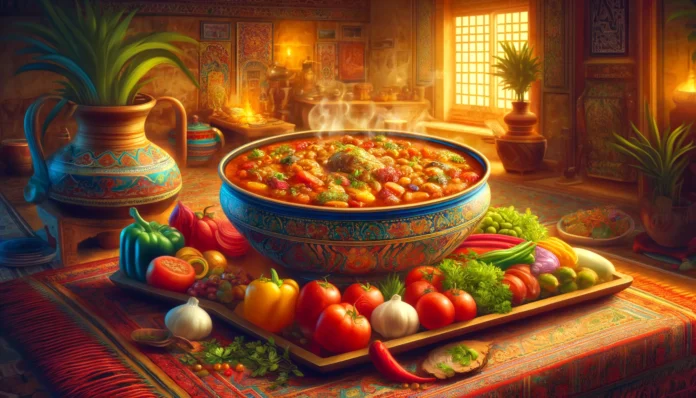Introduction to Maslaaseen
Maslaaseen is a traditional dish from the Middle East that’s loved for its rich flavors and comforting taste. This delectable stew is filled with goodness, made with various vegetables, meat, and spices. Across countries like Lebanon, Syria, and Jordan, Maslaaseen is more than just a meal; it’s a culinary experience that brings families and friends together, embodying the region’s warmth and hospitality.
The History and Tradition of Maslaaseen
The origin and history of Maslaaseen go back many generations, deeply rooted in the culture of the Middle East. Passed down through families and communities, it has been a part of Middle Eastern cuisine for centuries. Each family often has its unique recipe, reflecting local traditions and ingredients. Over time, Maslaaseen has evolved, yet it remains a symbol of abundance and togetherness, especially during cultural celebrations and festivals.
Maslaaseen Ingredients and Preparation
Ingredients
The beauty of Maslaaseen lies in its versatility and the richness of its ingredients. Here are the key components commonly found in various recipes:
- Vegetables: Carrots, potatoes, tomatoes, and onions form the base, providing a medley of textures and flavors.
- Meat: Lean cuts of lamb or beef are traditionally used, adding a hearty depth to the stew.
- Spices: A blend of spices such as cumin, coriander, cinnamon, and allspice are essential, infusing the dish with aromatic warmth.
- Herbs: Fresh herbs like parsley and cilantro are often added, contributing to the stew’s fresh and vibrant character.
Preparation
Preparing Maslaaseen is an art that involves slow simmering or braising. This method allows the flavors of the ingredients to meld together, creating a harmonious and rich stew. Here’s a basic preparation guide:
- Sautéing: Begin by sautéing onions in olive oil until they turn golden brown.
- Browning the Meat: Add the meat and brown it on all sides to seal in the juices.
- Adding Vegetables and Spices: Incorporate the vegetables and spices, stirring to coat everything evenly.
- Simmering: Add water or stock, bring to a boil, then reduce the heat and let it simmer slowly for a couple of hours.
- Finishing Touches: Before serving, sprinkle fresh herbs on top for a burst of flavor.
Regional Variations
One of the fascinating aspects of Maslaaseen is how it varies across different regions:
- Lebanon: Lebanese Maslaaseen often includes chickpeas and a generous use of garlic and lemon, giving it a distinct tangy taste.
- Syria: In Syria, the dish might feature eggplants and sweet spices like cinnamon and cloves, adding a unique sweetness to the stew.
- Jordan: Jordanian versions of Maslaaseen are hearty, with robust spices and sometimes incorporating yogurt for a creamy finish.
These variations reflect not only the diverse agricultural offerings of each region but also the distinct cultural practices that influence cooking methods and flavor profiles.
Tips for Cooking the Perfect Maslaaseen

For home cooks looking to master Maslaaseen, here are some practical tips:
- Quality Ingredients: Use the freshest vegetables and high-quality cuts of meat to enhance the depth of flavor.
- Patience in Cooking: Slow cooking is key. Allowing the stew to simmer for a longer period ensures that all the flavors meld perfectly.
- Seasoning: Taste as you go and adjust the seasoning gradually. Spices should complement, not overpower, the natural flavors of the ingredients.
- Personal Touch: Feel free to experiment with different vegetables and meats. Each variation can add a new and exciting dimension to the dish.
Maslaaseen in Modern Times
Despite the fast-paced changes in contemporary cuisine, Maslaaseen has retained its place of honor in Middle Eastern households. Its enduring popularity is a testament to its comforting nature and the sense of community it fosters. Today, it’s enjoyed not only in its traditional form but also in innovative variations that blend modern culinary techniques with age-old recipes.
Sharing Stories and Recipes
We’d love to hear from you! Do you have a cherished Maslaaseen recipe or a heartwarming story about enjoying this dish with loved ones? Share your experiences and variations with us in the comments below or on our social media channels. Let’s celebrate the rich tapestry of Maslaaseen together.
Conclusion
Maslaaseen is more than just a dish; it’s a cultural icon that embodies the essence of Middle Eastern hospitality and tradition. Whether you’re a seasoned chef or a home cook, exploring the world of Maslaaseen can be a deeply rewarding experience. So, why not try making it at home? Dive into the rich flavors and comforting warmth of this beloved stew and create your own piece of culinary history.
FAQ’ s
Q: What is Maslaaseen?
A: Maslaaseen is a traditional dish originating from the Middle East, renowned for its rich flavors and comforting taste. It is a hearty stew composed of a medley of vegetables, meat, and aromatic spices.
Q: Where does Maslaaseen originate from?
A: Maslaaseen has its roots in the culinary traditions of countries like Lebanon, Syria, and Jordan in the Middle East.
Q: What are the key ingredients in Maslaaseen?
A: The key ingredients in Maslaaseen typically include a variety of vegetables, such as potatoes, carrots, and tomatoes, along with meat, often lamb or chicken, and a blend of spices like cumin, cinnamon, and paprika.
Q: How is Maslaaseen prepared?
A: Maslaaseen is prepared by simmering vegetables and meat together in a flavorful broth infused with spices until they are tender and the flavors have melded together perfectly. It’s often served piping hot, accompanied by rice or bread.
Q: What makes Maslaaseen special?
A: Maslaaseen goes beyond being just a meal; it’s a culinary experience that embodies the warmth and hospitality of the Middle East. It brings families and friends together, offering a taste of tradition and heritage with every comforting spoonful.





